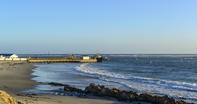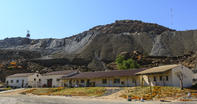World War 1
At the outbreak of World War 1, all copper mining in Namaqualand was suspended. This was because the government stopped the shipping of copper ore to Britain, preferring to keep the cargo space for products that were more important to the war effort.

The Namaqua Copper Company never fully recovered. Major operations were stopped in 1918 and smelting stopped in 1930. By 1931, the company was defunct, retaining only the mineral rights to its lands. The Phillips and King Group, on the other hand, had all the good mines and enjoyed a more sustained corporate history.
After commencing operations in 1853, the company did well until two partners in the firm died in 1862. This necessitated the dissolution of the concern and the whole enterprise was taken over by the newly formed Cape of Good Hope Copper Mining Company Ltd.
This soon became known, simply, as the Cape Copper Company. In the new company prospectus, it was announced that the company-owned mines had already exported 19 000 tons of high-grade ore, worth £500 000 pounds (with a profit of £115 000).
Cape Copper Company
For the next couple of decades, the Cape Copper Company continued to deliver solid results. But the outbreak of World War 1 put a serious dent in its finances. To make matters worse, 1918 was a bad year all round; falling ore grades, shortage of supplies and lack of access to markets all exacerbated the situation.
Then, in 1919, the Cape Copper Company suddenly suspended its operations with ‘a callousness and want of consideration and forethought for their employees, which was nothing short of culpable. In fact, on a single day, the company dismissed all the staff in one fell swoop, most with just a week’s severance pay. The shareholders, however, had done very well, making £217 for every initial share of £8. In 1920, the company started up again, mining on a small scale and selling off its accumulated stocks of ore.
It was eventually bought by an American consortium, who paid $750 000 for the company’s property. This new concern was named the South African Copper Company Limited, and it was involved mainly with exploratory work. In 1937, the O’okiep Copper Company was incorporated to buy out the South African Copper Company.
Shares in the new enterprise were taken up by a variety of international mining companies, with the Newmont Mining Corporation, based in America, as the largest shareholder. The O’okiep Copper Company’s assets included 105 000 acres of land, mineral rights to another 50 000 acres, equipment, the railway to Port Nolloth and the jetty at Port Nolloth.
Coming to an End

In 1939, the company bought the mineral leases held by the defunct Namaqua Copper Company for £2125 pounds. It now owned all the mines in Namaqualand. In 1940, it began milling and smelting operations and, in the following year it posted sales of £467 010 pounds, £109 125 of which were profit. These returns improved during World War 2 when the company secured contracts with the British and American defence departments.
After the war, East Okiep mine was opened and a pipeline to the Buffels River was constructed to supply the mines with water, which was always in short supply. In 1951, another mine called Wheal Julia opened. Several others followed: Hoit’s mine, Homeep, Jan Coetzee (famous for its quartz crystal formations), Carolusberg (the location of Van Der Stel’s original excavations in 1685) and Nigramoep. By 1975, the O’okiep Copper Company employed 1036 whites, 1996 coloureds and 2080 Africans.
But the life of their mines was limited and, by the 1990s, only Carolusberg and Nigramoep remained in operation. In 1997, the company gave all the houses in Okiep, Carolusberg and Nababeep to the current occupants, irrespective of their status. At that time, the company was managed by Goldfields of South Africa, but it was bought by Metrorex in 1999. Nigramoep, the last active mine, closed in 2004 and surface explorations were abandoned in the same year.
By David Fleminger